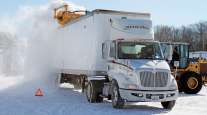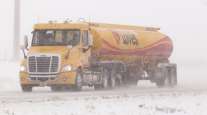Special to Transport Topics
Winterization Process Requires Preparation, Training

[Stay on top of transportation news: Get TTNews in your inbox.]
’Tis the season to be careful out there.
From treacherous road conditions to freezing temperatures, even the most conscientious drivers need to exert caution on the roads during the winter.
There are plenty of steps that both fleets and drivers should take in order to maximize safety. Perhaps the most important is to not wait until winter is already here but to start thinking about winter at least a month or two before the weather turns. The primary goal, experts say, is to never be surprised by an early winter storm.
Winter driving poses challenges. For instance, snow or debris entering exhaust systems causes dangerous exhaust fumes to seep into the cab. Fuel gelling is also a potential problem.
Winter Essentials
While preparing for the winter, here are some essential items that drivers should have in their trucks:
• Ice melt
• Water
• Warm blankets
• Food/snacks/canned goods
• Cleats for your shoes
• Flashlight
• Phone and charger
• Extra clothes
• Gloves
• Bag of toiletries
• Emergency signals
• Traction aids
• Emergency heat (candles)
• Extra bottles of antifreeze and oil
• Shovel
• Tools: vise grips, hammer
• Truck brushes
Source: Cox Automotive Mobility
“Another challenge is the faster accumulation of water in fuel water separators during winter. Drivers must be able to recognize this and drain it as needed,” said Chris Carter, vice president of maintenance with XPO. “The same goes for water in air lines; drivers need to know how to release water from air tanks to prevent brake freezing.”
He added that all of these issues can be addressed with proper training of drivers and proper winterizing of trucks before and during winter.
Another potential seasonal issue is moisture. Isaac Harmon, safety director with CPC Logistics, a provider of drivers for private fleets, said to watch out for any kind of moisture that can leak into air lines, which can cause cracks and issues with the tractor. Water can impact everything from brakes to transmission and could disable the vehicle.
Benjamin Deisig, senior mobile diesel technician with Cox Automotive Mobility, noted corrosion as an issue that is difficult to prevent.
“I don’t know many maintenance items that can prevent corrosion besides washing off the salt after winter driving. Inspectionwise, drivers should be looking for anything that would show corrosion is setting in,” he said, adding that focus should be placed on wiring and batteries, and anyplace where two different metals are contacting each other, like aluminum that’s in contact with steel, where the corrosion will most likely start.
Maintenance and Inspection Protocols
In order to prepare for winter, XPO implements a comprehensive winter weather plan across its nearly 300 service centers.

Driver training plays a key role in preparing for winter, such as understanding cab alerts and proactively monitoring road conditions. (XPO)
“Every year at the end of the season, we thoroughly evaluate what’s working and what’s not so we can learn from our experiences and make our plans continually better over time,” said Carter, noting weather differs region to region. The fleet has created custom plans for each climate situation. “These plans, like playbooks, are designed to meet the specific needs of each place and ensure its safe operation.”
He added that cleanliness and organization of the yards is the first step in winter prep. “This proactively helps us plow snow efficiently when winter weather hits while lowering the chances of damaging property or equipment,” said Carter. After that, supplies — salt, ice cleats, deicer and snow shovels — are made available to prevent accidents.
Pre- and post-inspection points are often checked more carefully in colder temperatures in areas of tire pressure and tread depth, noted Carter.
Harmon recommended that windshields be equipped with washer fluid, and that filters are working properly. “If you operate continuously in the Northeast, make sure diesel fuel has additives so it doesn’t gel, another top cause for trucks to break down,” he said, also recommending an in-trip inspection. “Do a walk-around on your vehicle any time you drop off a load. See if the lights are working, if there are audible sounds, and pay attention to how the vehicle is acting and working.”
Outside Dangers
National Weather Service forecasts can be accessed on most devices; however, monitoring the destination’s local news outlets is a wise choice, said Cox’s Deisig. “Inclement weather warnings are often displayed on interstate signs to alert you to weather issues you are about to face,” he added.

Fleets continue to implement comprehensive weather plans across North America this year as the winter season nears. (Cox Automotive Mobility)
XPO’s Carter noted that its local service centers watch events and road closures to provide real-time updates to their operations teams. However, some drivers rely on social media for weather updates, which are not always accurate and possibly false. Harmon said that weather apps are reliable as they can send push notifications. Ray Giguere, director of safety at SPC Transport, said that constant communication is key when it comes to road conditions, almost by the minute.
Despite the best efforts and precautions taken, a driver might need roadside assistance. Ideally, a fleet’s training program should address what to do in these situations and have emergency numbers at the ready.
“The safest thing to do in these conditions is to park the vehicle and let the bad weather pass,” Deisig said. “For some companies, not getting freight to its destination on time is an issue, but the cost of replacing that equipment if it’s in an accident shouldn’t be overlooked.”
Improving Winterization
Deisig insisted that some pre-inspection protocols should be beefed up in winter. “Some states in certain areas will require trucks to have chains for their tires, so having them is a must, and they need to be inspected before and after each use,” he said. “Something as simple as a bag of kitty litter in your truck could save you from a bad day stuck at a loading dock because of ice.”

A driver installs chains on his rig. Monitoring the local and national weather forecasts allows drivers to stay ahead of possible hazards. (Bruce Harmon/Trans Pixs)
Deisig recommended that trucking companies focus on air and cooling systems, the proper fuel additives and charging systems during the winterization process. Other important components include battery maintenance, starting aids like block heaters and intake heaters, coolant freeze protection, and keeping fuel treatment on hand.
The best advice is to avoid getting into a dangerous situation in the first place. If you must be out on the roads in inclement weather, drive slowly and defensively, keeping an eye out for other drivers on the road. A glaze of black ice is dangerous and often invisible to the naked eye as it can be confused for a wet road. However, both Giguere and Harmon advised drivers to look for any kind of water spray that comes off the tires of other vehicles: If no water kicks up, it’s a good indication that the road is frozen.
Deisig noted drivers should have their cellphones fully charged before leaving, as cold weather draws down battery power.
“If you do get into a situation where your vehicle is disabled, the No. 1 thing is to keep your core warm,” he added. “If you can’t keep your core warm, your body first slows circulation to your hands, feet, ears, etc., making it harder to warm them up.”

Harmon
Driver training plays a key role in preparing for winter, such as learning the various cab alerts and other climate-related issues.
“Communication is always key to success,” said Carter. “Drivers should be well-informed about the necessary actions and timings, understanding both safe and unsafe operating conditions. Ensuring safety during winter relies on the ability to identify potential hazards and make well-informed decisions.”
Harmon agreed, adding that onboarding a driver should include winter training safety, and it is worth hammering home the lessons regularly so that complacency does not set in. “The more you can refresh it and keep it in the front of a driver’s mind, the better chance you have of success,” he said.
Giguere said he focuses on educating his drivers about what to look out for mechanically. “Listen to the piece of equipment you’re driving; it will tell you what the issues are.”
Want more news? Listen to today's daily briefing below or go here for more info:




